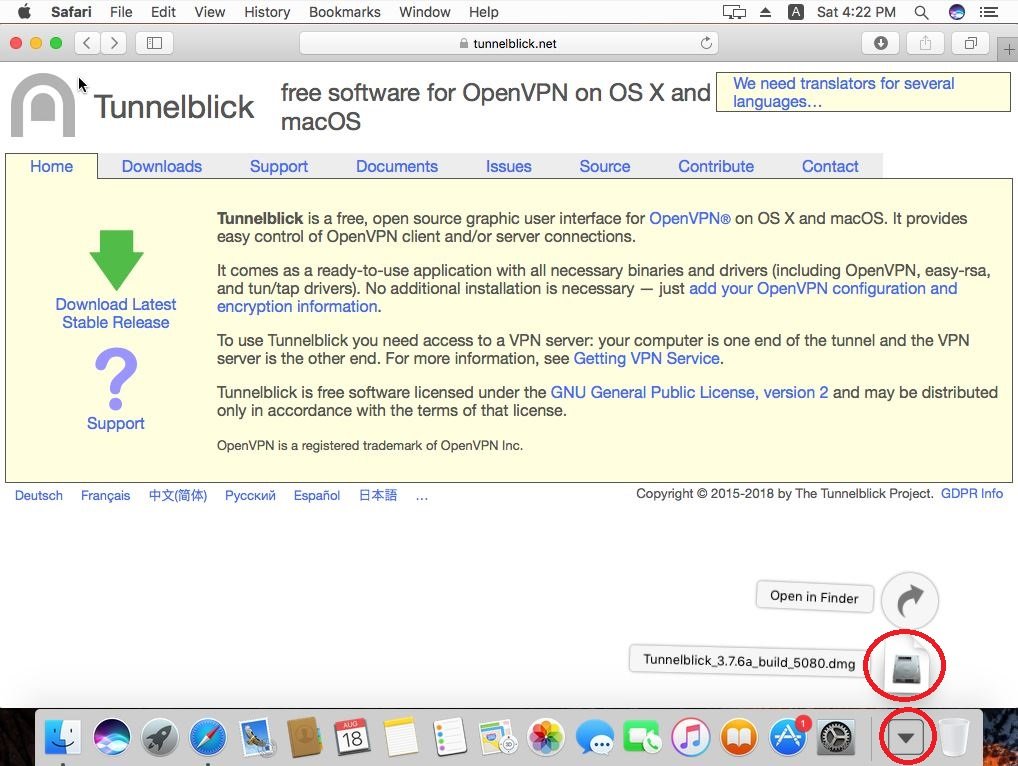Download Tunnelblick Vpn For Mac


Install Tunnelblick Mac

Navigate to your Downloads folder and double-click the Tunnelblick installation file you have just downloaded (it has a.dmg extension). In the window that opens, double-click on the Tunnelblick icon. A new dialogue box will pop up, asking you if you are sure you want to open the app. You will be asked to enter your Mac password. Tunnelblick is a simple graphical user interface for the great VPN software OpenVPN 2.0 and higher. It is written in Cocoa and comes in a ready to use distribution with all necessary binaries. To connect to the Cloud Management Platform using VPN from a Mac OS X computer, you need to perform these steps: Download and install an OpenVPN client for Mac OS X. Download your VPN client config file (called 'client.ovpn'). Run the OpenVPN client with the downloaded client config file. A popular OpenVPN client for Mac OS X is Tunnelblick.
Tunnelblick Vpn Client
Highlighted Articles Discussion Group | If you are using macOS 11 Big Sur, you should use the latest beta version of Tunnelblick. You should enable Tunnelblick to automatically check for updates to the latest beta version (on the 'Preferences' panel of Tunnelblick's 'VPN Details' window). You can also download the latest beta from Tunnelblick Downloads. The following is the current status of issues that have been seen using the latest beta version of Tunnelblick on beta and release versions of macOS Big Sur. To report an issue, please follow the instructions at Tunnelblick Issues. Please include the build number of macOS Big Sur under which the problem occurs. To get the build number, click on the small Apple icon at the top left corner of the screen and then click 'About This Mac'. A window will appear with information about your computer. The build number is the string of numbers and letters that appears in parentheses after 'Version 11'. You may need to click on 'Version 11' to see the build number. Tunnelblick's Tun and Tap system extensions do not load. If your configuration requires a 'tun' or 'tap' system extension, connecting to your VPN will fail if an appropriate system extension is not loaded. macOS Big Sur 11.0 Developer Beta 10 (20A5323l) does not allow Tunnelblick to load its 'tun' or 'tap' system extensions. Apple says that as a workaround 'during development' you can temporarily disable System Integrity Protection to allow these system extensions to load when logged in as an Admin user. This workaround may not work in the first release version of Big Sur — see The Future of Tun and Tap VPNs on macOS. Note: If you are using a 'tun' VPN, you can modify your OpenVPN configuration file so it will work without the 'tun' system extension. See the note at the start of Errors Loading Kexts (Device Drivers). Tunnelblick disables loading of Tun and Tap system extensions. When running on Big Sur, Tunnelblick Beta 3.8.4beta01 and higher force the settings on Tunnelblick's 'Advanced' settings window to 'never load' system extensions. You can override that behavior and allow the settings to act normally, which is useful if you have disabled SIP and/or your version of Big Sur allows Tunnelblick to load the system extensions. You can override the behavior by executing the following command in Terminal: The override can be removed by executing: FIXED IN Tunnelblick 3.8.3beta03: Tunnelblick refuses to run. Tunnelblick versions earlier than 3.8.3beta03 refuse to run on macOS Big Sur 11.0 Developer Beta 3 (20A5323l), complaining that the '/tmp' folder is not secure. Tunnelblick 3.8.3beta03 includes a fix for this problem. WON'T FIX: Sidecar does not work when a VPN is connected using Tunnelblick's default for a configuration. (This issue is not specific to Big Sur. It is present in all versions of Sidecar.) Sidecar does not work if IPv6 is disabled. By default, Tunnelblick disables IPv6 while a VPN is connected. This is done to prevent information leaks in common VPN setups (see A Glance through the VPN Looking Glass: IPv6 Leakage and DNS Hijacking in Commercial VPN clients). To fix this problem:
(This page was updated 2020-07-16.) |
